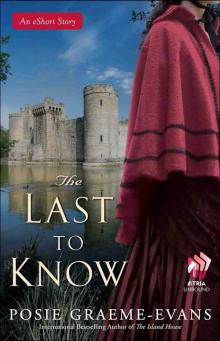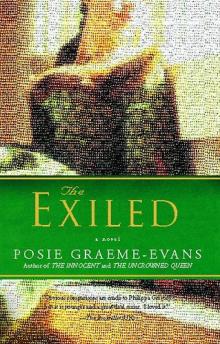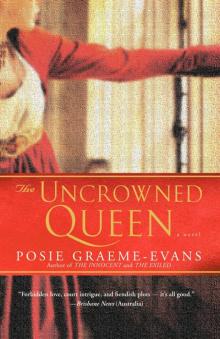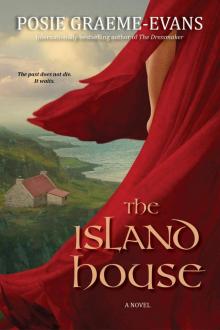- Home
- Posie Graeme-Evans
The Exiled Page 8
The Exiled Read online
Page 8
The beauty of the countryside, just glimpsed in the painted distance, brought wistfulness. Anne had so little time to give to that part of herself now: those empty fields, the dark forest and the glorious sky spoke of freedom, spoke of her childhood. How rare it was to be alone in this noisy city, how rare to touch natural things, smell the earth, listen to what the wind told her of the past, and the future.
Tears were near the surface again. Too many complex and contradictory feelings filled her now — she needed time to sort them privately.
It was a bold work she’d commissioned, herself at the centre of it, not out of vanity but out of certainty, out of hope. She’d made herself Mary’s companion and they looked like friends, because this mother of God was young and blonde like Jenna, with hair carefully arranged loose over her shoulders — the symbol of virginity. Anne recognised the model, she was a seamstress Deborah hired from time to time to help make up clothes for the household. That made her smile — how astonishing yet how apt to give the Virgin a servant’s face.
The ‘Christ Child’ sat on his mother’s lap, one tiny hand raised in blessing as his charmingly benevolent gaze took in both the viewer and the supplicant, and commissioner, of the painting — Anne at his ‘mother’s’ feet.
Anne was delighted with the likeness of the boy — she’d persuaded Memlinc to use little Edward. The painter chuckled as he saw her look carefully at Edward’s face. ‘He only squirmed a little, lady. I’ve had worse. Your sister’s son is a fine child. She would have been proud of him — if I may say that.’
Anne hardly heard what the painter said. She was lost in the face of the little boy in front of her. The baby looked amused, his mouth was open in a happy smile, you almost expected to hear the warm, milky gurgle of his laughter. He was the delightful, almost carnal centre of the picture, his flesh painted with a pearl-like glimmer. Surely, this eternally giggling child was an affirmation that life could be good and that God loved each one of his creatures. And how odd that viewers of this painting, in years to come, would not know that it was truly a picture of a mother and her son — though Anne was not the woman with the halo.
There was a fourth figure in the painting. The image of a knight wearing jousting armour, his plumed helm open so that face and eyes could be seen in the shadow of the visor, and in his hand, a shortened jousting lance. He also had a shield with the red cross of Saint George upon it, plain and unadorned.
This knight had one foot firmly upon a vigorously writhing, quarter-sized dragon, which, like Anne’s foot, seemed almost to fall out of the picture into the lap of the viewer.
And then Anne saw the colour of the knight’s armour. It was black; and the knight’s eyes were a most intense blue. Breath deserted her; this Saint George had Edward Plantagenet’s eyes — and his jousting armour. Ice touched her, fire also. Unwilling to believe what she saw, Anne’s voice shook slightly as she spoke.
‘Where did you find the model for Saint George, Meinheer?’ Even to her own ears, she sounded strained.
‘Well now, Sir Knight is an oddity; he’s got a bit from here, a bit from there. I use ordinary people for saint’s faces — as you know. I don’t want to use well-known people; if you’ve met them, it breaks the illusion and it’s too distracting. But this Saint George was hard to paint — he just wouldn’t come, wouldn’t form properly, even though I worked with two different men from the markets. They cost me to pay off, I can tell you that, though I kept something of each of them: the hands, there, they come from one man; the neck, the set of the shoulders from the other.’
It seemed to Anne that he was holding something back. She breathed her question, ‘But his eyes?’
The painter shuffled his feet, embarrassed. ‘Well, they came from an English boy I saw once: a young nobleman. There were family connections to the court here and he spent one summer with the old duke and his family. Our current duke taught this boy to joust when he was young — the boy had black practice armour, and I used to watch them sometimes, at the quintain. I just imagined what he might look like now. It was a strong face even then, of course, and I’ve never forgotten his eyes, but that’s my trade.’
It was an omen, a sign. They were still connected, why else would his face find its way into this painting?
‘Edward — the King of England? As a young man?’
He mistook her tone for dislike. ‘I can paint the face out if you like, mistress. I was guessing what he’d look like now, building on memory.’ He shrugged. ‘It’s a small skill I have, to remember people’s faces. But if you don’t like it?’
Anne shook her head and she could not keep the joy out of her voice. ‘No. It is a wonderful painting. Extraordinary. You are not to change it, any of it.’
That was enough for Meinheer Memlinc. If she was happy, so was he. He was reasonably unsentimental about his work generally. Perhaps, like a wet-nurse, he knew his ‘children’ — the paintings he made — never truly belonged to him, even though he gave them life. Sometimes, after all the sweat and anguish of making a picture work, he was even glad to see them swaddled in wrappings, ready to leave his studio. But this one was different, perhaps because Anne had been such an intriguing subject.
He’d badly wanted to capture that combination of vulnerability, purpose and sensuality he felt in her. She was capable of a direct innocence that generally deserted children quite early, but it was allied to an edge like a sword, when that was needed. And he wanted to paint her again, badly. A portrait this time — just of her. Perhaps as the Magdalene, if she would permit that?
He’d have to find a way to broach the subject, tactfully, when she was used to living with this work she’d commissioned. After all, now, as she aged, she would always have the reminder of what she’d once been. That might be disturbing, as beauty fled.
Yes, his picture might come to be a mixed blessing, in time.
Chapter Ten
Anne was anxious as Phillip, the strongest man in Mathew’s stable, tried his best to hang the picture of her unexpectedly real family group — Anne, her Saint George and their son — in the parlour.
The painting had been brought home to Mathew’s house with some ceremony, arriving at almost the same time as Anne’s guardian and his wife tied up in their barge at their own water gate. Now the press of people in this small room, all giving poor Phillip contradictory advice, was actively getting in the way of what Anne wanted.
Mathew Cuttifer was the worst — he fancied himself a judge of artwork, having commissioned so much for Blessing House in London.
‘No, no, Phillip. Look man, that’s not nearly high enough. You want it to hang higher, where it’s out of the afternoon sun. We don’t want the colours fading!’
‘Mathew, I can’t agree. It needs the light to be seen properly — all those wonderful colours. It should come down a little and be further towards the window. The light is not direct in any case — it will not harm the pigments. Meinheer Memlinc said so.’
Lady Margaret, Mathew Cuttifer’s sensible wife, was brisk. She knew a thing or two about painting as well. Deborah discreetly rolled her eyes at Anne — at this rate they’d still all be going by evening prayers. The girl did her best not to laugh.
‘Sir Mathew, I think I agree with Lady Margaret. The painting needs the light. Each detail is so exquisite — they all deserve to be seen clearly. I will watch to see that the colours do not fade — perhaps we can have a cover made for summer days?’
Sir Mathew was not convinced, but he found himself out-voted. There were times when this formidable merchant found the look in his wife’s eyes more frightening than facing the king. This was one of those times.
‘Well then, I suppose we should live with it on the wall for a time. See if you like it in the place you have chosen. I find that things change — season to season, for instance, the light is different. You may not always want it on that wall. Or as low as that ...’ He caught Margaret’s eye. Oh, very well. He would not say any more.
De
borah left the room quietly to see about something pleasing to drink — they must celebrate. Today, now the painting had come home, was an extraordinary day, and it was somehow a symbol of changed times and strange possibilities.
Anne, Lady Margaret, Sir Mathew and Deborah. These four people alone — along with the formidable figure of ‘Saint George’ in the painting — knew the secret of Anne’s past.
Sir Mathew stood thoughtfully in front of the canvas of this unexpected family group. He knew it was a remarkable painting — finer than anything he had — and very bold, if one knew the true history of the figures within it.
It made him shiver that Edward’s eyes, an impression of his adult face, had found their way inside that jousting helm. Like Anne, it felt to him like an omen — something profoundly significant — but who did the dragon represent? There was a snake in the garden of Eden — dragons and snakes were both symbols of evil and destruction, surely?
Mathew was at war with himself, and he knew it. Hours before, when he and Margaret had landed in Sluis, he’d been presented with the news of the wedding to be, and of Anne’s bold plans for beating the merchants of Brugge at their own game.
Mathew Cuttifer had not made his money from being timorous. He understood risk, but prudent risk was always best: risk when one broadly knew that the odds were running in one’s favour. What Anne had proposed to him was something that ran against almost every trading instinct he possessed — almost, but not quite. A small flicker of excitement ran beneath the caution. He remembered the instinctive boldness of his youth, that boldness which had begun his fortune.
And so, with little time to assess all that Anne was proposing, he’d unexpectedly agreed: he would co-invest in the cargoes to come from Italy. Devilry lay deep in his soul it seemed; God grant that he would not live to regret backing his ‘ward’, his ex-servant, the illegitimate daughter of his own ‘old king’...
Deborah brought Mathew back to the present, offering a blue-green waldeglas beaker filled with hot wine. He took it and turned back to the women who surrounded him. ‘To Saint George. The Protector of England, the protector of women.’
So much was unsaid as they repeated his words ‘To Saint George’, but Anne was deeply warmed. Once more, against his own good judgment, it seemed, Mathew Cuttifer had committed himself and his house to stand beside her when the risk was at its greatest. If he had truly been her father, she would have kissed him now; and somehow he knew, she was sure of that, for when he raised his own glass, he smiled and winked!
A discreet knock at the open door of the parlour broke the moment. Friar Giorgio stood there uncertainly. This was very much a family gathering.
‘Father Giorgio, come in. See now, here is the Lady Anne’s fine new painting. You know much of such matters, as I’m told.’
Sir Mathew, like his friend William Caxton, was uneasy in the friar’s presence, but he hid it better.
Anne smiled at Giorgio and slipped an arm through his as they stood in front of the canvas together. ‘There. I cannot judge my own face, though others tell me that the likeness is good of the child.’
Ordinarily the friar was scathing about the so-called arts of the Low Countries — he saw them as primitive, old-fashioned and undeveloped. To him, real culture began and ended within the city states of his own divided homeland — and, just possibly, within the walls of Paris — but here, today, in front of this canvas, he was silenced. It was a great painting. Somehow the painter had caught the essence, the truth of each of his sitters.
The peasant seamstress who portrayed the Mother of God truly shone down on her audience, her own simple humanity as great a crown as that worn by the Empress of Heaven. Never had Christ’s mother seemed more accessible, more compassionate, more comforting and more real.
And the baby, the happy Christ child, still gave hints of strength, even majesty, in the blessing of that raised hand, confidently signing the cross over Anne as she knelt at his feet.
But it was in Anne’s face and Saint George’s face that the greatness of the work was most strikingly displayed. The sheer technical accomplishment — the luminance of the flesh, the solidity of the figures, the pleasing balance of the shapes, the remarkable depth of the world they inhabited — was far outweighed by the natural power of these two painted faces. It was as if Hans Memlinc had dipped his brush in truth and laid it out on his canvas — and the personal qualities he’d found in each of his subject’s faces sent Father Giorgio’s scalp into a prickle of strangeness.
Hans Memlinc had painted strength and purpose into Anne’s eyes, and charm also. It was not a look he saw often from the girl herself, like many women she was careful to keep her eyes down in public so that she would not cause offence by glancing directly into a man’s eyes — but in unguarded moments he had seen it. Sometimes those green-blue eyes were a sword in her service — a glance that said, ‘Be careful of what I could be if you cross me.’
Yet her mouth contradicted the eyes. It was certainly sensual — deeply, softly clear red, the same red as her scarlet dress — and yet so yielding, so soft; slightly open with a hint of the white teeth beneath as the short upper lip lifted in an awed, tender smile for the baby Christ. The pure mouth of a child who was not yet a woman. An innocent mouth.
Giorgio was not a man to linger over the qualities of a woman’s mouth, but he understood the vulnerable sensuality of it in this painting.
And Saint George — now there was a face. The nose was long and fine, the planes of the face clear and well modelled within the shadow of the helm. But again, the eyes — peering out of the shadow, flecked with light as if they burned — were blue stars, glittering with the edge of a honed and wicked knife. There was no quarter in that face, no pity, but there was a powerful sense that the knight was there to protect the kneeling woman, and the child, as if this was the only task God had ever given him. And the blood pouring in ruddy, graceful coils from the dragon’s neck was witness to that fact. And the two faces, his and hers, were oddly alike. They might almost have been male and female versions of the same person.
Sir Mathew interrupted the friar’s reverie. ‘And so, Father Giorgio, tell us. Is this not as fine as any work you might see in Florence or Rome?’
Gracefully, the priest bowed. ‘Indeed, sir, I am delighted and surprised to say that it is. I have never been a scholar of your northern painters, but this Meinheer Memlinc could have a most promising career if he chose to work at any of the courts in Italy.’
Anne laughed. ‘But, Father, he’s so busy here in Brugge that he has no need to go elsewhere. He already has a great career.’ The friar blushed a little — sensitive that he had unwittingly patronised these people, which was not clever of him. ‘Ah, lady, I did not wish to give offence. I merely observe that all the great masters working today can find ready commissions from the noble families of my country — and the Vatican — after all. So much building, so much adornment in all forms, so many extraordinary men at work. We can all learn from the greatness of others.’
‘Amen to that, Father. Amen to that. And now, it is our pleasure to learn from you. Since we have the attention of Sir Mathew and Lady Margaret, perhaps you and I should tell them of some of the wonderful things you have brought to us from your travels. What the ladies are currently wearing in Florence, for instance; this new fashion for flowers embroidered in precious stones on gauze overdresses for the warmer months? That will translate here. I believe we should have some made up to sell for the Lady Margaret’s wedding.’
Mathew looked at Anne speculatively. There was a new, confident tone in her voice; she was nervous, but she spoke as he would have, like a merchant who saw an opening in the market.
Friar Giorgio clapped his hands for Jenna — the girl had been waiting outside the parlour in case she should be needed — and sent her to bring the saddle bags from his room. He had many things to show his new business partners, things that could be made and sold in the next few months as excitement mounted in the town of B
rugge ahead of the royal wedding; things which would deliver a great deal of money to the new joint venture between Mathew Cuttifer and Anne de Bohun — if the cargoes from Venice and Florence were landed in time; if they survived the spring gales; if the Guild allowed them to be sold.
And if none of these things happened, Anne would be ruined.
Part
Two
The Merchant
Chapter Eleven
Anne woke with a start in the dead middle of the night — before even cockerels called out dawn to the sleeping city.
She sat up in bed, hugging her knees, shivering, feeling sick. Bad dreams had pursued her after Edward’s birth, but she’d thought that time was past.
Perhaps it was the imminence of the marriage — the marriage of Edward’s sister — that was stirring up the emotional mud in her life once more. She still felt guilty about Elisabeth Wydeville — that she’d allowed the king, the man Elisabeth had married, to seduce her. Guilty, yes, but not regretful. If she was honest.
Thoughts of Edward always made Anne’s heart lurch, even now; therefore, how could she go back to sleep? Quickly she pulled the fur coverlet from the bed around her shoulders and slipped out of her warm sheets, over to the window which looked down to the canal.
The winter ice was long gone and the canal was placid in the light of the setting moon. It was the still time of night — the hush before the world woke and stretched. The air felt different and suddenly Anne realised why — she wasn’t cold.
Anne pushed one of the heavy, leaded casements open, and leant out into the soft air as far as she could. Spring! The air smelt of earth and green leaves after rain. The year had turned away from winter at last and summer was truly close.

 The Last to Know
The Last to Know The Exiled
The Exiled The Uncrowned Queen
The Uncrowned Queen The Island House
The Island House Wild Wood
Wild Wood